Exploring Digital Business: Transformation, Tech & Business Theories
VerifiedAdded on 2023/06/17
|9
|2671
|436
Report
AI Summary
This report explores the importance of digital transformation in modern business, detailing its development, key technologies (mobile applications, cloud computing, IoT, digital twins, AI), and technological platforms (collaborative suites, communication tools, intranet platforms). It examines how various industries utilize digital transformation as a business tool for promotion and security, linking it to business theories like Henri Fayol's Principles of Administrative Management. The report concludes that adopting digital transformation is crucial for companies to adapt to changing customer habits, expand into new markets, and maintain a competitive edge. Desklib offers this report and many other resources for students.
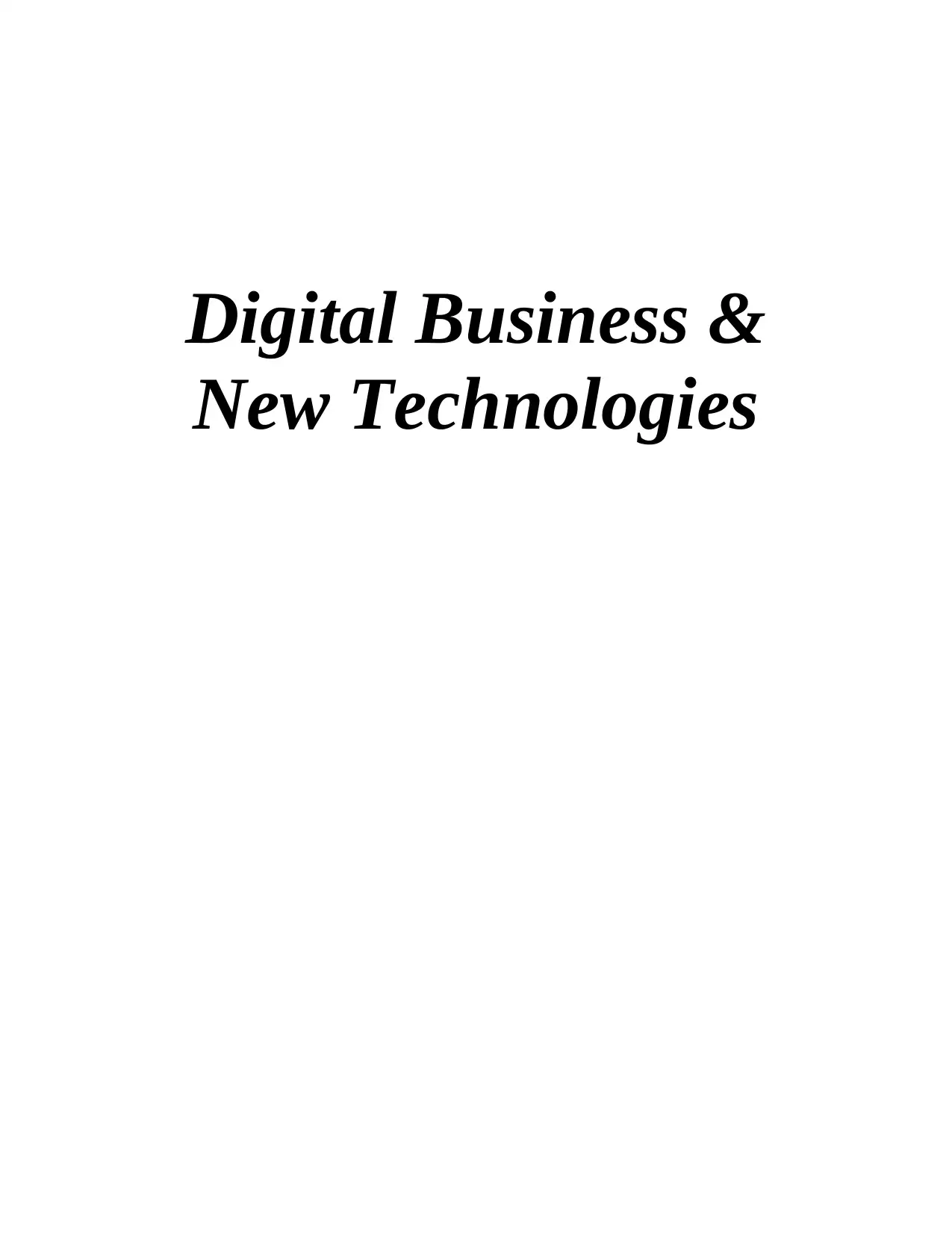
Digital Business &
New Technologies
New Technologies
Paraphrase This Document
Need a fresh take? Get an instant paraphrase of this document with our AI Paraphraser
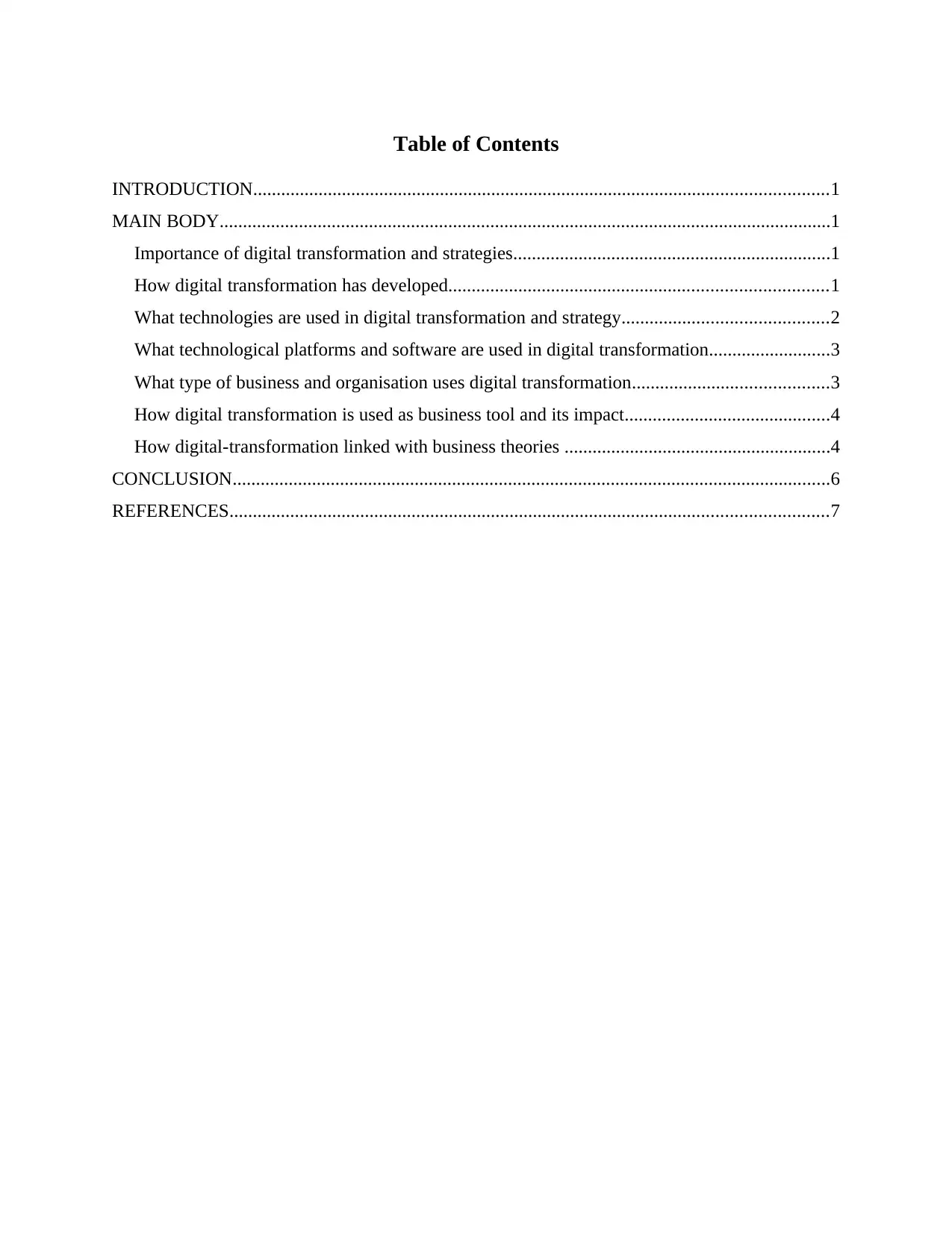
Table of Contents
INTRODUCTION...........................................................................................................................1
MAIN BODY...................................................................................................................................1
Importance of digital transformation and strategies....................................................................1
How digital transformation has developed.................................................................................1
What technologies are used in digital transformation and strategy............................................2
What technological platforms and software are used in digital transformation..........................3
What type of business and organisation uses digital transformation..........................................3
How digital transformation is used as business tool and its impact............................................4
How digital-transformation linked with business theories .........................................................4
CONCLUSION................................................................................................................................6
REFERENCES................................................................................................................................7
INTRODUCTION...........................................................................................................................1
MAIN BODY...................................................................................................................................1
Importance of digital transformation and strategies....................................................................1
How digital transformation has developed.................................................................................1
What technologies are used in digital transformation and strategy............................................2
What technological platforms and software are used in digital transformation..........................3
What type of business and organisation uses digital transformation..........................................3
How digital transformation is used as business tool and its impact............................................4
How digital-transformation linked with business theories .........................................................4
CONCLUSION................................................................................................................................6
REFERENCES................................................................................................................................7
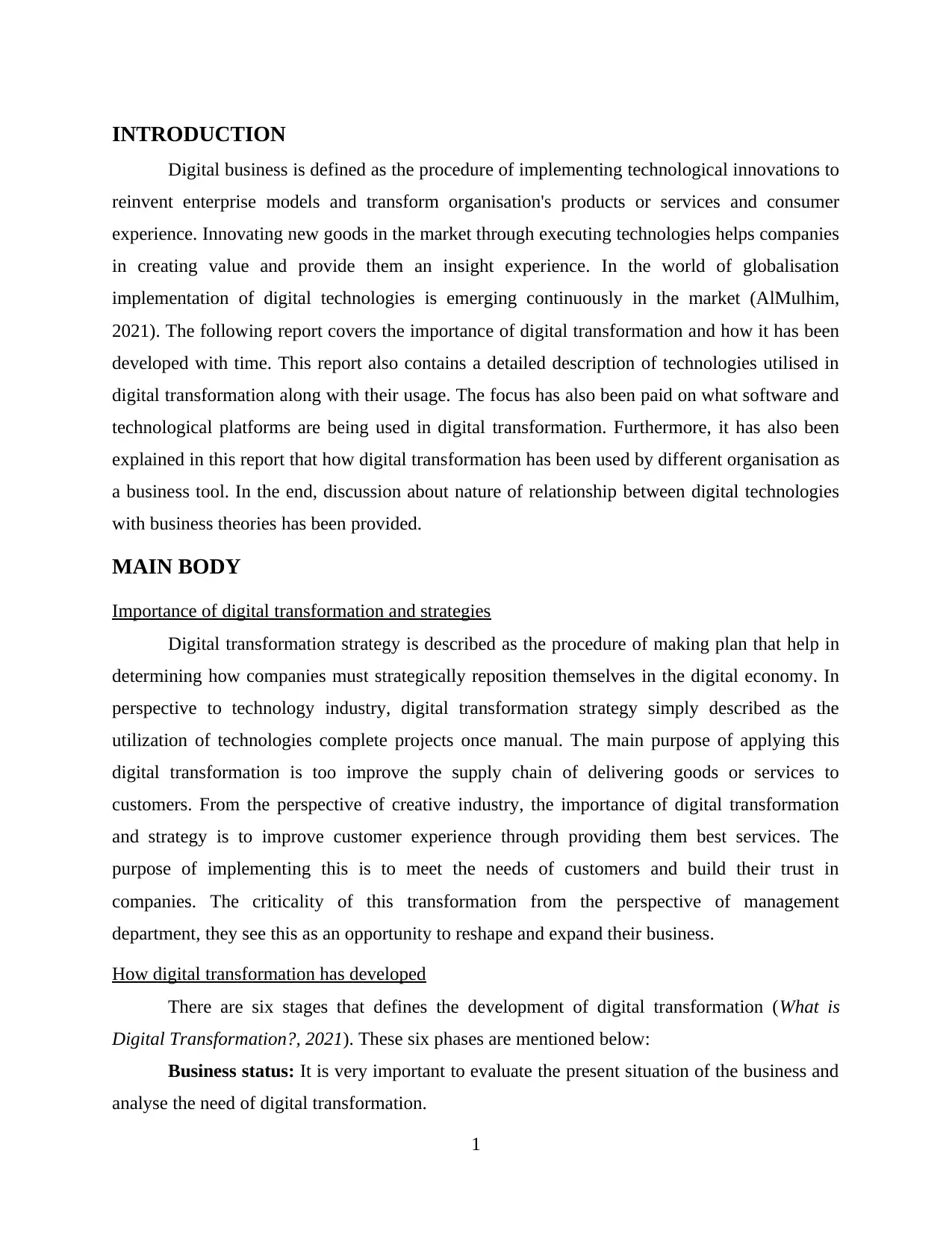
INTRODUCTION
Digital business is defined as the procedure of implementing technological innovations to
reinvent enterprise models and transform organisation's products or services and consumer
experience. Innovating new goods in the market through executing technologies helps companies
in creating value and provide them an insight experience. In the world of globalisation
implementation of digital technologies is emerging continuously in the market (AlMulhim,
2021). The following report covers the importance of digital transformation and how it has been
developed with time. This report also contains a detailed description of technologies utilised in
digital transformation along with their usage. The focus has also been paid on what software and
technological platforms are being used in digital transformation. Furthermore, it has also been
explained in this report that how digital transformation has been used by different organisation as
a business tool. In the end, discussion about nature of relationship between digital technologies
with business theories has been provided.
MAIN BODY
Importance of digital transformation and strategies
Digital transformation strategy is described as the procedure of making plan that help in
determining how companies must strategically reposition themselves in the digital economy. In
perspective to technology industry, digital transformation strategy simply described as the
utilization of technologies complete projects once manual. The main purpose of applying this
digital transformation is too improve the supply chain of delivering goods or services to
customers. From the perspective of creative industry, the importance of digital transformation
and strategy is to improve customer experience through providing them best services. The
purpose of implementing this is to meet the needs of customers and build their trust in
companies. The criticality of this transformation from the perspective of management
department, they see this as an opportunity to reshape and expand their business.
How digital transformation has developed
There are six stages that defines the development of digital transformation (What is
Digital Transformation?, 2021). These six phases are mentioned below:
Business status: It is very important to evaluate the present situation of the business and
analyse the need of digital transformation.
1
Digital business is defined as the procedure of implementing technological innovations to
reinvent enterprise models and transform organisation's products or services and consumer
experience. Innovating new goods in the market through executing technologies helps companies
in creating value and provide them an insight experience. In the world of globalisation
implementation of digital technologies is emerging continuously in the market (AlMulhim,
2021). The following report covers the importance of digital transformation and how it has been
developed with time. This report also contains a detailed description of technologies utilised in
digital transformation along with their usage. The focus has also been paid on what software and
technological platforms are being used in digital transformation. Furthermore, it has also been
explained in this report that how digital transformation has been used by different organisation as
a business tool. In the end, discussion about nature of relationship between digital technologies
with business theories has been provided.
MAIN BODY
Importance of digital transformation and strategies
Digital transformation strategy is described as the procedure of making plan that help in
determining how companies must strategically reposition themselves in the digital economy. In
perspective to technology industry, digital transformation strategy simply described as the
utilization of technologies complete projects once manual. The main purpose of applying this
digital transformation is too improve the supply chain of delivering goods or services to
customers. From the perspective of creative industry, the importance of digital transformation
and strategy is to improve customer experience through providing them best services. The
purpose of implementing this is to meet the needs of customers and build their trust in
companies. The criticality of this transformation from the perspective of management
department, they see this as an opportunity to reshape and expand their business.
How digital transformation has developed
There are six stages that defines the development of digital transformation (What is
Digital Transformation?, 2021). These six phases are mentioned below:
Business status: It is very important to evaluate the present situation of the business and
analyse the need of digital transformation.
1
⊘ This is a preview!⊘
Do you want full access?
Subscribe today to unlock all pages.

Trusted by 1+ million students worldwide
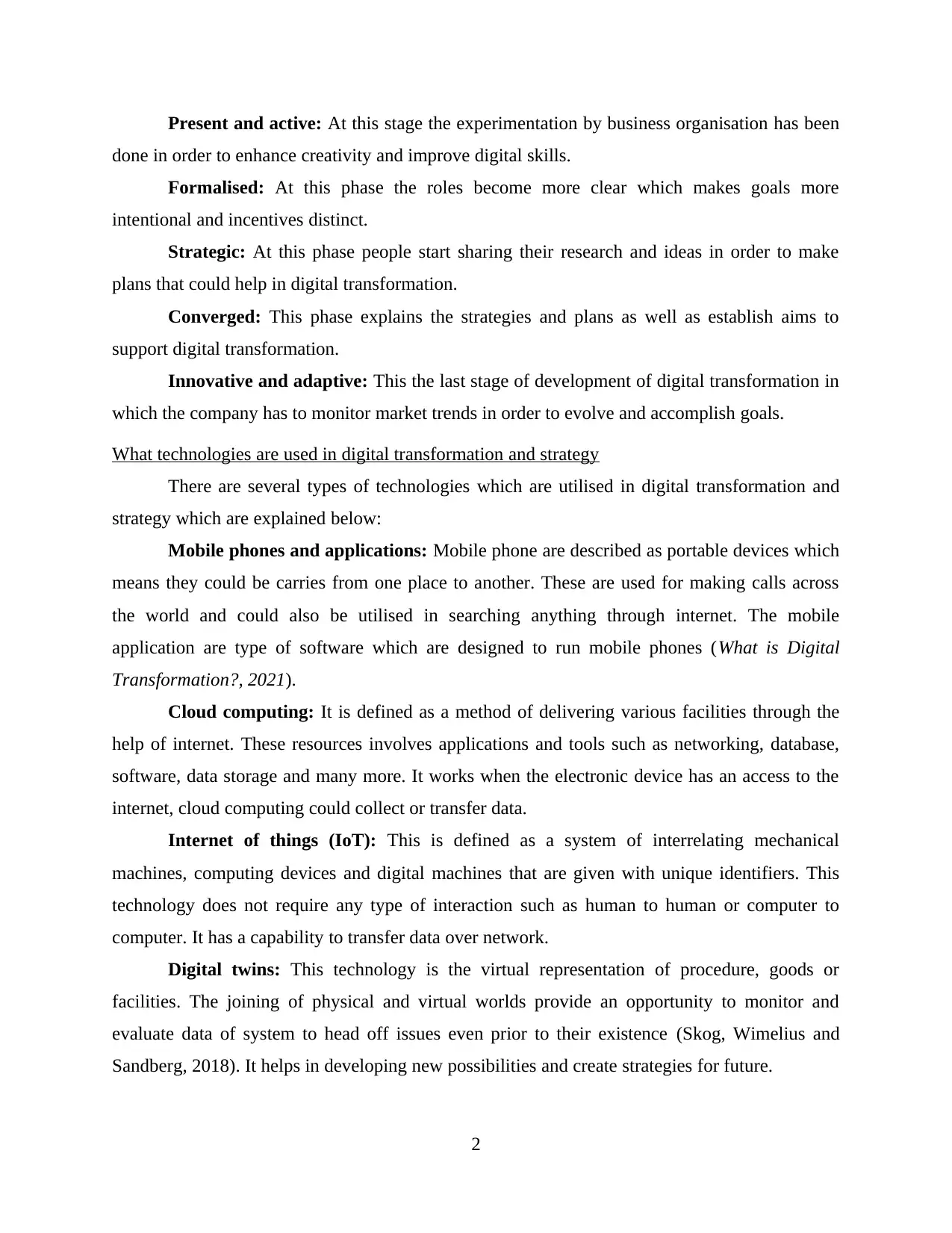
Present and active: At this stage the experimentation by business organisation has been
done in order to enhance creativity and improve digital skills.
Formalised: At this phase the roles become more clear which makes goals more
intentional and incentives distinct.
Strategic: At this phase people start sharing their research and ideas in order to make
plans that could help in digital transformation.
Converged: This phase explains the strategies and plans as well as establish aims to
support digital transformation.
Innovative and adaptive: This the last stage of development of digital transformation in
which the company has to monitor market trends in order to evolve and accomplish goals.
What technologies are used in digital transformation and strategy
There are several types of technologies which are utilised in digital transformation and
strategy which are explained below:
Mobile phones and applications: Mobile phone are described as portable devices which
means they could be carries from one place to another. These are used for making calls across
the world and could also be utilised in searching anything through internet. The mobile
application are type of software which are designed to run mobile phones (What is Digital
Transformation?, 2021).
Cloud computing: It is defined as a method of delivering various facilities through the
help of internet. These resources involves applications and tools such as networking, database,
software, data storage and many more. It works when the electronic device has an access to the
internet, cloud computing could collect or transfer data.
Internet of things (IoT): This is defined as a system of interrelating mechanical
machines, computing devices and digital machines that are given with unique identifiers. This
technology does not require any type of interaction such as human to human or computer to
computer. It has a capability to transfer data over network.
Digital twins: This technology is the virtual representation of procedure, goods or
facilities. The joining of physical and virtual worlds provide an opportunity to monitor and
evaluate data of system to head off issues even prior to their existence (Skog, Wimelius and
Sandberg, 2018). It helps in developing new possibilities and create strategies for future.
2
done in order to enhance creativity and improve digital skills.
Formalised: At this phase the roles become more clear which makes goals more
intentional and incentives distinct.
Strategic: At this phase people start sharing their research and ideas in order to make
plans that could help in digital transformation.
Converged: This phase explains the strategies and plans as well as establish aims to
support digital transformation.
Innovative and adaptive: This the last stage of development of digital transformation in
which the company has to monitor market trends in order to evolve and accomplish goals.
What technologies are used in digital transformation and strategy
There are several types of technologies which are utilised in digital transformation and
strategy which are explained below:
Mobile phones and applications: Mobile phone are described as portable devices which
means they could be carries from one place to another. These are used for making calls across
the world and could also be utilised in searching anything through internet. The mobile
application are type of software which are designed to run mobile phones (What is Digital
Transformation?, 2021).
Cloud computing: It is defined as a method of delivering various facilities through the
help of internet. These resources involves applications and tools such as networking, database,
software, data storage and many more. It works when the electronic device has an access to the
internet, cloud computing could collect or transfer data.
Internet of things (IoT): This is defined as a system of interrelating mechanical
machines, computing devices and digital machines that are given with unique identifiers. This
technology does not require any type of interaction such as human to human or computer to
computer. It has a capability to transfer data over network.
Digital twins: This technology is the virtual representation of procedure, goods or
facilities. The joining of physical and virtual worlds provide an opportunity to monitor and
evaluate data of system to head off issues even prior to their existence (Skog, Wimelius and
Sandberg, 2018). It helps in developing new possibilities and create strategies for future.
2
Paraphrase This Document
Need a fresh take? Get an instant paraphrase of this document with our AI Paraphraser
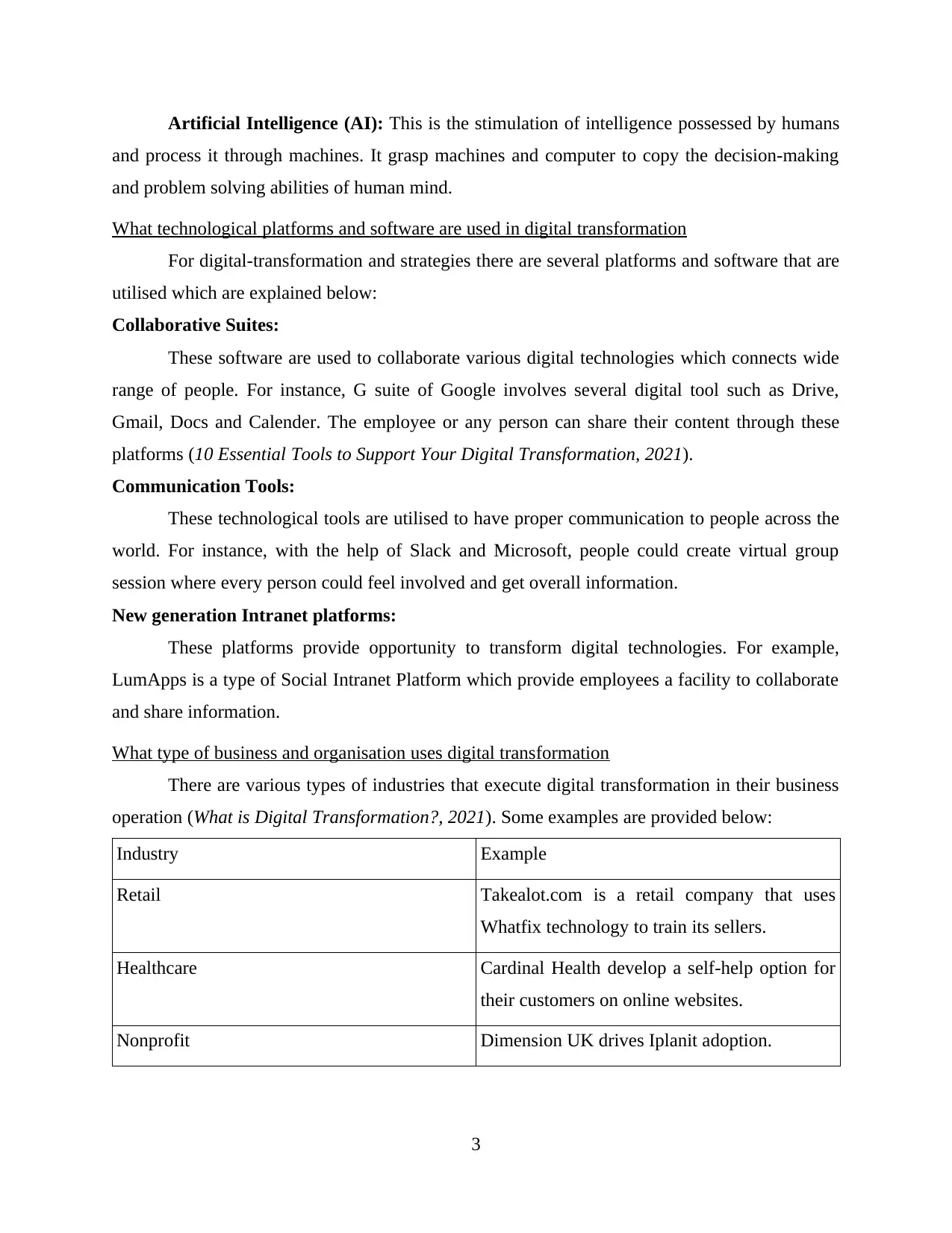
Artificial Intelligence (AI): This is the stimulation of intelligence possessed by humans
and process it through machines. It grasp machines and computer to copy the decision-making
and problem solving abilities of human mind.
What technological platforms and software are used in digital transformation
For digital-transformation and strategies there are several platforms and software that are
utilised which are explained below:
Collaborative Suites:
These software are used to collaborate various digital technologies which connects wide
range of people. For instance, G suite of Google involves several digital tool such as Drive,
Gmail, Docs and Calender. The employee or any person can share their content through these
platforms (10 Essential Tools to Support Your Digital Transformation, 2021).
Communication Tools:
These technological tools are utilised to have proper communication to people across the
world. For instance, with the help of Slack and Microsoft, people could create virtual group
session where every person could feel involved and get overall information.
New generation Intranet platforms:
These platforms provide opportunity to transform digital technologies. For example,
LumApps is a type of Social Intranet Platform which provide employees a facility to collaborate
and share information.
What type of business and organisation uses digital transformation
There are various types of industries that execute digital transformation in their business
operation (What is Digital Transformation?, 2021). Some examples are provided below:
Industry Example
Retail Takealot.com is a retail company that uses
Whatfix technology to train its sellers.
Healthcare Cardinal Health develop a self-help option for
their customers on online websites.
Nonprofit Dimension UK drives Iplanit adoption.
3
and process it through machines. It grasp machines and computer to copy the decision-making
and problem solving abilities of human mind.
What technological platforms and software are used in digital transformation
For digital-transformation and strategies there are several platforms and software that are
utilised which are explained below:
Collaborative Suites:
These software are used to collaborate various digital technologies which connects wide
range of people. For instance, G suite of Google involves several digital tool such as Drive,
Gmail, Docs and Calender. The employee or any person can share their content through these
platforms (10 Essential Tools to Support Your Digital Transformation, 2021).
Communication Tools:
These technological tools are utilised to have proper communication to people across the
world. For instance, with the help of Slack and Microsoft, people could create virtual group
session where every person could feel involved and get overall information.
New generation Intranet platforms:
These platforms provide opportunity to transform digital technologies. For example,
LumApps is a type of Social Intranet Platform which provide employees a facility to collaborate
and share information.
What type of business and organisation uses digital transformation
There are various types of industries that execute digital transformation in their business
operation (What is Digital Transformation?, 2021). Some examples are provided below:
Industry Example
Retail Takealot.com is a retail company that uses
Whatfix technology to train its sellers.
Healthcare Cardinal Health develop a self-help option for
their customers on online websites.
Nonprofit Dimension UK drives Iplanit adoption.
3

How digital transformation is used as business tool and its impact
There are various benefits that digital-transformation provides to business which helps
them in gaining competitive advantage in the market. These benefits provide opportunity to
companies to use digital-transformation as a business tool. These are described below:
Promotion:
The various digital technologies are used by companies to promote their product or
services on several online platforms such as Facebook, Instagram and others (Manners-Bell and
Lyon, 2019). This positively impact the company as these platforms help companies in reaching
more customer base and enhancing their profitability.
Security:
Digital technologies also helps companies in providing safety to them by protecting their
data and information from hacking or cyber threat. The companies are also be able to secure the
information of their clients through digital technologies.
How digital-transformation linked with business theories
The business theories are defined as the procedure of managing system in an organisation
which helps it in enhancing their employees engagement (Kyrychenko, 2020). The business
theory which is linked with the digital transformation is described below in detail:
Principles Of Administrative Management
This theory was purposed by Henri Fayol who was a miner and engineer. He examined
that there are six principles which are required to follow whenever companies decide to bring
any changes in their organisation (Chinoracký and Čorejová, 2019). The digital transformation
strategies include the innovation of new technology known as Online services through mobile
application. This launch of new innovation is linked with the six principles of business theory
which are as follows:
Organise: For bringing new technological transformation in the market companies need
to plan and make strategies which cold help them in developing new innovative products. The
management department of the organisation is required to organise all the activities in the
company by appointing suitable candidates (Volkodavova and Tomazova, 2019). The managers
of the company are required to assign roles and responsibilities to employees according to their
skills which could assist in the successful development of the product. The company need to
execute suitable organisational structure which could aids them in providing clear system and
4
There are various benefits that digital-transformation provides to business which helps
them in gaining competitive advantage in the market. These benefits provide opportunity to
companies to use digital-transformation as a business tool. These are described below:
Promotion:
The various digital technologies are used by companies to promote their product or
services on several online platforms such as Facebook, Instagram and others (Manners-Bell and
Lyon, 2019). This positively impact the company as these platforms help companies in reaching
more customer base and enhancing their profitability.
Security:
Digital technologies also helps companies in providing safety to them by protecting their
data and information from hacking or cyber threat. The companies are also be able to secure the
information of their clients through digital technologies.
How digital-transformation linked with business theories
The business theories are defined as the procedure of managing system in an organisation
which helps it in enhancing their employees engagement (Kyrychenko, 2020). The business
theory which is linked with the digital transformation is described below in detail:
Principles Of Administrative Management
This theory was purposed by Henri Fayol who was a miner and engineer. He examined
that there are six principles which are required to follow whenever companies decide to bring
any changes in their organisation (Chinoracký and Čorejová, 2019). The digital transformation
strategies include the innovation of new technology known as Online services through mobile
application. This launch of new innovation is linked with the six principles of business theory
which are as follows:
Organise: For bringing new technological transformation in the market companies need
to plan and make strategies which cold help them in developing new innovative products. The
management department of the organisation is required to organise all the activities in the
company by appointing suitable candidates (Volkodavova and Tomazova, 2019). The managers
of the company are required to assign roles and responsibilities to employees according to their
skills which could assist in the successful development of the product. The company need to
execute suitable organisational structure which could aids them in providing clear system and
4
⊘ This is a preview!⊘
Do you want full access?
Subscribe today to unlock all pages.

Trusted by 1+ million students worldwide

effective communication can be developed. The proper organisational structure will help
company in planning strategically and the goal of developing product could be accomplished
smoothly.
Command: To produce a product successfully it is required to execute effective
leadership style that helps managers of the company to guide and direct employees properly. For
developing digital product it is very important to provide correct procedure that could assist
companies in making that good correctly (Romagnolo, 2018). Employees of the company are
required to follow the direction and guidance provided by their leaders so that they cold achieve
success in making application. Leaders must execute suitable leadership style which could help
them in encouraging employees and boost their morale to obtain completion of product.
Control: Companies need to have overall control in every activity that is happening in
the procedure of making digital-transformation. The leaders are advised to supervise actions of
employees and possess ability to control them. The right control by leaders will reduce the
chances of conflicts and employees will work with full dedication. Organisations must appoint
those candidates who have power to control a group of people and could influence them with
their actions. Companies must motivate their employees to achieve success and improve their
technical skills which could help in the procedure of digital-transformation.
Coordinate: In order to achieve successful formation of product it is very crucial that
every member of the organisation have better understanding with each other. The leaders need to
organise team building exercises which could help organisation in developing coordination
among employees. Employees must share information and ideas that could assist in making the
application more creative. The participation of employees in decision-making procedure should
be increases in order to make the process smooth and enhancing their engagement in the
company as well as in project (Vial, 2019). By promoting diversity in the company, it could
develop a sense of respect in employees which will help them in understanding needs of different
customers. The coordinate will assist in making digital-transformation process more smooth and
successful.
Plan: After having full control and coordination within organisation, the companies need
to discuss their plan with every one. This will help in examining the effectiveness of project
through gaining feedbacks from different people. The companies need to plan their strategies
which could bring more profitability and improve their brand image in market. At his phase
5
company in planning strategically and the goal of developing product could be accomplished
smoothly.
Command: To produce a product successfully it is required to execute effective
leadership style that helps managers of the company to guide and direct employees properly. For
developing digital product it is very important to provide correct procedure that could assist
companies in making that good correctly (Romagnolo, 2018). Employees of the company are
required to follow the direction and guidance provided by their leaders so that they cold achieve
success in making application. Leaders must execute suitable leadership style which could help
them in encouraging employees and boost their morale to obtain completion of product.
Control: Companies need to have overall control in every activity that is happening in
the procedure of making digital-transformation. The leaders are advised to supervise actions of
employees and possess ability to control them. The right control by leaders will reduce the
chances of conflicts and employees will work with full dedication. Organisations must appoint
those candidates who have power to control a group of people and could influence them with
their actions. Companies must motivate their employees to achieve success and improve their
technical skills which could help in the procedure of digital-transformation.
Coordinate: In order to achieve successful formation of product it is very crucial that
every member of the organisation have better understanding with each other. The leaders need to
organise team building exercises which could help organisation in developing coordination
among employees. Employees must share information and ideas that could assist in making the
application more creative. The participation of employees in decision-making procedure should
be increases in order to make the process smooth and enhancing their engagement in the
company as well as in project (Vial, 2019). By promoting diversity in the company, it could
develop a sense of respect in employees which will help them in understanding needs of different
customers. The coordinate will assist in making digital-transformation process more smooth and
successful.
Plan: After having full control and coordination within organisation, the companies need
to discuss their plan with every one. This will help in examining the effectiveness of project
through gaining feedbacks from different people. The companies need to plan their strategies
which could bring more profitability and improve their brand image in market. At his phase
5
Paraphrase This Document
Need a fresh take? Get an instant paraphrase of this document with our AI Paraphraser

companies decide who are the potential customers for their mobile application and how they can
reach them to attract them towards their product (Lohman, 2021). The companies plan the way
of entering the market and reaching more customer base which could bring profitability and
growth. Different digital tools and online promotion will help the companies in marketing their
products so that it could grasp large attention of targeted potential customers.
Forecast: This the final step of the business theory which explains that companies after
making analysing their strategies need to execute those in the market. After finalising the
procedure, organisations are required to launch the application in the market (Turlacu, Chivu and
Herrezeel, 2019). After the introduction of the product, companies are advised to take continuous
feedbacks from people in order to understand the further needs of the product. This will also help
them in understanding strengths and weakness of the product which will further help them in
improving their services more.
CONCLUSION
From the above report it has been analysed that in today's world it is very important for
companies to adopt digital transformation. As customer habits are switching from traditional
purchasing to online trading which the companies need to understand in order to remain in the
market for long time. Digital business also help organisations to move with continuously and
expand their business in new market. The digital technologies uses various technological tool
and software to remain updated. It has also been observed that several companies execute these
digital changes to make themselves stand out in the market and to provide best services for their
potential customer base. In the end, it could be concluded that organisations need to make
strategies for digital transformation which could help them in their growth and productivity.
6
reach them to attract them towards their product (Lohman, 2021). The companies plan the way
of entering the market and reaching more customer base which could bring profitability and
growth. Different digital tools and online promotion will help the companies in marketing their
products so that it could grasp large attention of targeted potential customers.
Forecast: This the final step of the business theory which explains that companies after
making analysing their strategies need to execute those in the market. After finalising the
procedure, organisations are required to launch the application in the market (Turlacu, Chivu and
Herrezeel, 2019). After the introduction of the product, companies are advised to take continuous
feedbacks from people in order to understand the further needs of the product. This will also help
them in understanding strengths and weakness of the product which will further help them in
improving their services more.
CONCLUSION
From the above report it has been analysed that in today's world it is very important for
companies to adopt digital transformation. As customer habits are switching from traditional
purchasing to online trading which the companies need to understand in order to remain in the
market for long time. Digital business also help organisations to move with continuously and
expand their business in new market. The digital technologies uses various technological tool
and software to remain updated. It has also been observed that several companies execute these
digital changes to make themselves stand out in the market and to provide best services for their
potential customer base. In the end, it could be concluded that organisations need to make
strategies for digital transformation which could help them in their growth and productivity.
6

REFERENCES
Books and Journals
AlMulhim, A.F., 2021. Smart supply chain and firm performance: the role of digital
technologies. Business Process Management Journal.
Chinoracký, R. and Čorejová, T., 2019. Impact of digital technologies on labor market and the
transport sector. Transportation research procedia, 40, pp.994-1001.
Kyrychenko, M., 2020. Digital strategic concept formation of modern Ukrainian society in the
context of technologies, possibilities and breakthrough development. Humanities
Studies, (4 (81)), pp.30-44.
Lohman, L., 2021. The LEAPS Framework for Selecting Digital Technologies in Online, Hybrid,
and Face-to-Face Course Design. Currents in Teaching & Learning, 12(2).
Manners-Bell, J. and Lyon, K., 2019. The logistics and supply chain innovation handbook:
Disruptive technologies and new business models. Kogan Page Publishers.
Romagnolo, C., 2018. New Digital Technologies in Industrial districts: the case of Veneto
Region (Bachelor's thesis, Università Ca'Foscari Venezia).
Skog, D.A., Wimelius, H. and Sandberg, J., 2018. Digital disruption. Business & Information
Systems Engineering, 60(5), pp.431-437.
Turlacu, L.M., Chivu, R.G. and Herrezeel, T., 2019. Strategic technologies: Innovation in higher
education in Romania. In The International Scientific Conference eLearning and
Software for Education (Vol. 1, pp. 400-406). " Carol I" National Defence University.
Vial, G., 2019. Understanding digital transformation: A review and a research agenda. The
journal of strategic information systems, 28(2), pp.118-144.
Volkodavova, E.V. and Tomazova, O.V., 2019. Digital Technologies in the Control System for
Equipment Reconditioning in Oil and Gas Companies. In SHS Web of Conferences
(Vol. 62, p. 09001). EDP Sciences.
[Online]
What is Digital Transformation?. 2021. Online available through: <https://whatfix.com/digital-
transformation/#sec7>./
10 Essential Tools to Support Your Digital Transformation. 2021. Online available through:
<https://www.lumapps.com/solutions/digital-transformation/digital-transformation-
tools/>./
7
Books and Journals
AlMulhim, A.F., 2021. Smart supply chain and firm performance: the role of digital
technologies. Business Process Management Journal.
Chinoracký, R. and Čorejová, T., 2019. Impact of digital technologies on labor market and the
transport sector. Transportation research procedia, 40, pp.994-1001.
Kyrychenko, M., 2020. Digital strategic concept formation of modern Ukrainian society in the
context of technologies, possibilities and breakthrough development. Humanities
Studies, (4 (81)), pp.30-44.
Lohman, L., 2021. The LEAPS Framework for Selecting Digital Technologies in Online, Hybrid,
and Face-to-Face Course Design. Currents in Teaching & Learning, 12(2).
Manners-Bell, J. and Lyon, K., 2019. The logistics and supply chain innovation handbook:
Disruptive technologies and new business models. Kogan Page Publishers.
Romagnolo, C., 2018. New Digital Technologies in Industrial districts: the case of Veneto
Region (Bachelor's thesis, Università Ca'Foscari Venezia).
Skog, D.A., Wimelius, H. and Sandberg, J., 2018. Digital disruption. Business & Information
Systems Engineering, 60(5), pp.431-437.
Turlacu, L.M., Chivu, R.G. and Herrezeel, T., 2019. Strategic technologies: Innovation in higher
education in Romania. In The International Scientific Conference eLearning and
Software for Education (Vol. 1, pp. 400-406). " Carol I" National Defence University.
Vial, G., 2019. Understanding digital transformation: A review and a research agenda. The
journal of strategic information systems, 28(2), pp.118-144.
Volkodavova, E.V. and Tomazova, O.V., 2019. Digital Technologies in the Control System for
Equipment Reconditioning in Oil and Gas Companies. In SHS Web of Conferences
(Vol. 62, p. 09001). EDP Sciences.
[Online]
What is Digital Transformation?. 2021. Online available through: <https://whatfix.com/digital-
transformation/#sec7>./
10 Essential Tools to Support Your Digital Transformation. 2021. Online available through:
<https://www.lumapps.com/solutions/digital-transformation/digital-transformation-
tools/>./
7
⊘ This is a preview!⊘
Do you want full access?
Subscribe today to unlock all pages.

Trusted by 1+ million students worldwide
1 out of 9
Related Documents
Your All-in-One AI-Powered Toolkit for Academic Success.
+13062052269
info@desklib.com
Available 24*7 on WhatsApp / Email
![[object Object]](/_next/static/media/star-bottom.7253800d.svg)
Unlock your academic potential
Copyright © 2020–2025 A2Z Services. All Rights Reserved. Developed and managed by ZUCOL.


